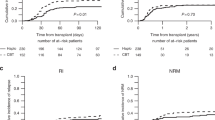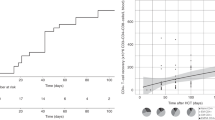Abstract
Unrelated cord blood transplantation (UCBT) after a reduced intensity conditioning regimen (RIC) has extended the use of UCB in elderly patients and those with co-morbidities without an HLA-identical donor, although post-transplant relapse remains a concern in high-risk acute myeloid leukemia (AML) patients. HLA incompatibilities between donor and recipient might enhance the alloreactivity of natural killer (NK) cells after allogeneic hematopoietic stem-cell transplantation (HSCT). We studied the reconstitution of NK cells and KIR-L mismatch in 54 patients who underwent a RIC-UCBT for AML in CR in a prospective phase II clinical trial. After RIC-UCBT, NK cells displayed phenotypic features of both activation and immaturity. Restoration of their polyfunctional capacities depended on the timing of their acquisition of phenotypic markers of maturity. The incidence of treatment-related mortality (TRM) was correlated with low CD16 expression (P=0.043) and high HLA-DR expression (P=0.0008), whereas overall survival was associated with increased frequency of NK-cell degranulation (P=0.001). These features reflect a general impairment of the NK licensing process in HLA-mismatched HSCT and may aid the development of future strategies for selecting optimal UCB units and enhancing immune recovery.
This is a preview of subscription content, access via your institution
Access options
Subscribe to this journal
Receive 12 print issues and online access
$259.00 per year
only $21.58 per issue
Buy this article
- Purchase on Springer Link
- Instant access to full article PDF
Prices may be subject to local taxes which are calculated during checkout




Similar content being viewed by others
References
Ruggeri A, Labopin M, Sanz G, Piemontese S, Arcese W, Bacigalupo A et al. Comparison of outcomes after unrelated cord blood and unmanipulated haploidentical stem cell transplantation in adults with acute leukemia. Leukemia 2015; 29: 1891–1900.
Michel G, Galambrun C, Sirvent A, Pochon C, Bruno B, Jubert C et al. Single- vs double-unit cord blood transplantation for children and young adults with acute leukemia or myelodysplastic syndrome. Blood 2016; 127: 3450–3457.
Ballen KK, Gluckman E, Broxmeyer HE . Umbilical cord blood transplantation: the first 25 years and beyond. Blood 2013; 122: 491–498.
Milano F, Gooley T, Wood B, Woolfrey A, Flowers ME, Doney K et al. Cord-blood transplantation in patients with minimal residual disease. N Engl J Med 2016; 375: 944–953.
Liu H, Stock W, Bishop MR . Expanded indications for allogeneic stem cell transplantation in patients with myeloid malignancies. Curr Opin Hematol 2013; 20: 115–122.
Brunstein CG, Wagner JE, Weisdorf DJ, Cooley S, Noreen H, Barker JN et al. Negative effect of KIR alloreactivity in recipients of umbilical cord blood transplant depends on transplantation conditioning intensity. Blood 2009; 113: 5628–5634.
Nguyen S, Dhedin N, Vernant JP, Kuentz M, Al Jijakli A, Rouas-Freiss N et al. NK-cell reconstitution after haploidentical hematopoietic stem-cell transplantations: immaturity of NK cells and inhibitory effect of NKG2A override GvL effect. Blood 2005; 105: 4135–4142.
Mancusi A, Ruggeri L, Velardi A . Haploidentical hematopoietic transplantation for the cure of leukemia: from its biology to clinical translation. Blood 2016; 128: 2616–2623.
Guillerey C, Huntington ND, Smyth MJ . Targeting natural killer cells in cancer immunotherapy. Nat Immunol 2016; 17: 1025–1036.
Saunders PM, Vivian JP, O'Connor GM, Sullivan LC, Pymm P, Rossjohn J et al. A bird's eye view of NK cell receptor interactions with their MHC class I ligands. Immunol Rev 2015; 267: 148–166.
Sun JC, Lanier LL . NK cell development, homeostasis and function: parallels with CD8+ T cells. Nat Rev Immunol 2011; 11: 645–657.
Vivier E, Raulet DH, Moretta A, Caligiuri MA, Zitvogel L, Lanier LL et al. Innate or adaptive immunity? The example of natural killer cells. Science 2011; 331: 44–49.
Koch J, Steinle A, Watzl C, Mandelboim O . Activating natural cytotoxicity receptors of natural killer cells in cancer and infection. Trends Immunol 2013; 34: 182–191.
Venstrom JM, Pittari G, Gooley TA, Chewning JH, Spellman S, Haagenson M et al. HLA-C-dependent prevention of leukemia relapse by donor activating KIR2DS1. N Engl J Med 2012; 367: 805–816.
Nguyen S, Béziat V, Roos-Weil D, Vieillard V . Role of natural killer cells in hematopoietic stem cell transplantation: myth or reality? J Innate Immun 2011; 3: 383–394.
Willemze R, Rodrigues CA, Labopin M, Sanz G, Michel G, Socié G et al. KIR-ligand incompatibility in the graft-versus-host direction improves outcomes after umbilical cord blood transplantation for acute leukemia. Leukemia 2009; 23: 492–500.
Foley B, Felices M, Cichocki F, Cooley S, Verneris MR, Miller JS . The biology of NK cells and their receptors affects clinical outcomes after hematopoietic cell transplantation (HCT). Immunol Rev 2014; 258: 45–63.
Cooley S, Weisdorf DJ, Guethlein LA, Klein JP, Wang T, Marsh SG et al. Donor killer cell Ig-like receptor B haplotypes, recipient HLA-C1, and HLA-C mismatch enhance the clinical benefit of unrelated transplantation for acute myelogenous leukemia. J Immunol 2014; 192: 4592–4600.
Rio B, Chevret S, Vigouroux S, Chevallier P, Fürst S, Sirvent A et al. Decreased nonrelapse mortality after unrelated cord blood transplantation for acute myeloid leukemia using reduced-intensity conditioning: a prospective phase II multicenter trial. Biol Blood Marrow Transplant 2015; 21: 445–453.
Beziat V, Nguyen S, Lapusan S, Hervier B, Dhedin N, Bories D et al. Fully functional NK cells after unrelated cord blood transplantation. Leukemia 2009; 23: 721–728.
Béziat V, Hervier B, Achour A, Boutolleau D, Marfain-Koka A, Vieillard V . Human NKG2A overrides NKG2C effector functions to prevent autoreactivity of NK cells. Blood 2011; 117: 4394–4396.
Roederer M, Nozzi JL, Nason MC . SPICE: exploration and analysis of post-cytometric complex multivariate datasets. Cytometry A 2011; 79: 167–174.
Ruggeri A, Peffault de Latour R, Carmagnat M, Clave E, Douay C, Larghero J et al. Outcomes, infections, and immune reconstitution after double cord blood transplantation in patients with high-risk hematological diseases. Transpl Infect Dis 2011; 13: 456–465.
Parham P . Immunology. NK cells lose their inhibition. Science 2004; 305: 786–787.
Hou L, Chen M, Steiner NK, Belle I, Turino C, Ng J et al. Seventeen novel alleles add to the already extensive KIR3DL3 diversity. Tissue Antigens 2007; 70: 449–454.
Babor F, Manser AR, Fischer JC, Scherenschlich N, Enczmann J, Chazara O et al. KIR ligand C2 is associated with increased susceptibility to childhood ALL and confers an elevated risk for late relapse. Blood 2014; 124: 2248–2251.
Miller JS, Blazar BR . Control of acute myeloid leukemia relapse—dance between KIRs and HLA. N Engl J Med 2012; 367: 866–868.
Imai K, Matsuyama S, Miyake S, Suga K, Nakachi K . Natural cytotoxic activity of peripheral-blood lymphocytes and cancer incidence: an 11-year follow-up study of a general population. Lancet 2000; 356: 1795–1799.
Béziat V, Descours B, Parizot C, Debré P, Vieillard V . NK cell terminal differentiation: correlated stepwise decrease of NKG2A and acquisition of KIRs. PLoS ONE 2010; 5: e11966.
Moretta L . Dissecting CD56dim human NK cells. Blood 2010; 116: 3689–3691.
Dulphy N, Haas P, Busson M, Belhadj S, Peffault de Latour R, Robin M et al. An unusual CD56(bright) CD16(low) NK cell subset dominates the early posttransplant period following HLA-matched hematopoietic stem cell transplantation. J Immunol 2008; 181: 2227–2237.
Béziat V, Duffy D, Quoc SN, Le Garff-Tavernier M, Decocq J, Combadière B et al. CD56brightCD16+ NK cells: a functional intermediate stage of NK cell differentiation. J Immunol 2011; 186: 6753–6761.
Shimoni A, Hardan I, Avigdor A, Yeshurun M, Raanani P, Ben-Bassat I et al. Rituximab reduces relapse risk after allogeneic and autologous stem cell transplantation in patients with high-risk aggressive non-Hodgkin's lymphoma. Br J Haematol 2003; 122: 457–464.
Pfeiffer M, Stanojevic S, Feuchtinger T, Greil J, Handgretinger R, Barbin K et al. Rituximab mediates in vitro antileukemic activity in pediatric patients after allogeneic transplantation. Bone Marrow Transplant 2005; 36: 91–97.
Kulkarni S, Martin MP, Carrington M . The Yin and Yang of HLA and KIR in human disease. Semin Immunol 2008; 20: 343–352.
Nguyen S, Béziat V, Norol F, Uzunov M, Trebeden-Negre H, Azar N et al. Infusion of allogeneic natural killer cells in a patient with acute myeloid leukemia in relapse after haploidentical hematopoietic stem cell transplantation. Transfusion 2011; 51: 1769–1778.
Fischer JC, Ottinger H, Ferencik S, Sribar M, Punzel M, Beelen DW et al. Relevance of C1 and C2 epitopes for hemopoietic stem cell transplantation: role for sequential acquisition of HLA-C-specific inhibitory killer Ig-like receptor. J Immunol 2007; 178: 3918–3923.
Nguyen S, Kuentz M, Vernant JP, Dhedin N, Bories D, Debré P et al. Involvement of mature donor T cells in the NK cell reconstitution after haploidentical hematopoietic stem-cell transplantation. Leukemia 2008; 22: 344–352.
Bari R, Rujkijyanont P, Sullivan E, Kang G, Turner V, Gan K et al. Effect of donor KIR2DL1 allelic polymorphism on the outcome of pediatric allogeneic hematopoietic stem-cell transplantation. J Clin Oncol 2013; 31: 3782–3790.
Giebel S, Locatelli F, Wojnar J, Velardi A, Mina T, Giorgiani G et al. Homozygosity for human leucocyte antigen-C ligands of KIR2DL1 is associated with increased risk of relapse after human leucocyte antigen-C-matched unrelated donor haematopoietic stem cell transplantation. Br J Haematol 2005; 131: 483–486.
Single RM, Martin MP, Gao X, Meyer D, Yeager M, Kidd JR et al. Global diversity and evidence for coevolution of KIR and HLA. Nat Genet 2007; 39: 1114–1119.
Nakimuli A, Chazara O, Farrell L, Hiby SE, Tukwasibwe S, Knee O et al. Killer cell immunoglobulin-like receptor (KIR) genes and their HLA-C ligands in a Ugandan population. Immunogenetics 2013; 65: 765–775.
Acknowledgements
We thank all transplantation centers participating in this study, the Société Française de Greffe de Moelle Osseuse et Thérapie Cellulaire (SFGM-TC), and the Eurocord office. We also thank the personnel from the Etablissement Français du Sang (EFS) for the healthy adult blood samples and the staff at the gynecology and obstetrics department of Pitié-Salpêtrière Hospital (Paris, France) for the cord blood samples. This work was funded by the Institut National du Cancer (AOM06206), the Ministère des Affaires Sociales et de la Santé (DGOS, AOR12106), the Agence de la Biomédecine, the association Laurette Fugain, and the association Capucine.
Author information
Authors and Affiliations
Corresponding authors
Ethics declarations
Competing interests
The authors declare no conflict of interest.
Additional information
Supplementary Information accompanies this paper on Bone Marrow Transplantation website
Supplementary information
Rights and permissions
About this article
Cite this article
Nguyen, S., Achour, A., Souchet, L. et al. Clinical impact of NK-cell reconstitution after reduced intensity conditioned unrelated cord blood transplantation in patients with acute myeloid leukemia: analysis of a prospective phase II multicenter trial on behalf of the Société Française de Greffe de Moelle Osseuse et Thérapie Cellulaire and Eurocord. Bone Marrow Transplant 52, 1428–1435 (2017). https://doi.org/10.1038/bmt.2017.122
Received:
Revised:
Accepted:
Published:
Issue Date:
DOI: https://doi.org/10.1038/bmt.2017.122
This article is cited by
-
Reduced leukemia relapse through cytomegalovirus reactivation in killer cell immunoglobulin-like receptor-ligand-mismatched cord blood transplantation
Bone Marrow Transplantation (2021)
-
Altered effect of killer immunoglobulin-like receptor–ligand mismatch by graft versus host disease prophylaxis in cord blood transplantation
Bone Marrow Transplantation (2021)



